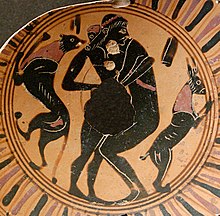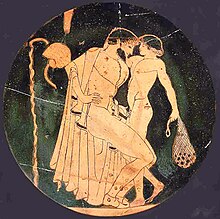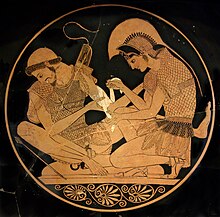Homosexuality in ancient Greece

In classical antiquity, writers such as Herodotus,[1] Plato,[2] Xenophon,[3] Athenaeus[4] and many others explored aspects of homosexuality in Greece. The most widespread and socially significant form of same-sex sexual relations in ancient Greece was between adult men and pubescent or adolescent boys, known as pederasty (marriages in Ancient Greece between men and women were also age structured, with men in their thirties commonly taking wives in their early teens).[5] Though sexual relationships between adult men did exist, at least one member of each of these relationships flouted social conventions by assuming a passive sexual role. It is unclear how such relations between women were regarded in the general society, but examples do exist as far back as the time of Sappho.[6]
The ancient Greeks did not conceive of sexual orientation as a social identifier as modern Western societies have done. Greek society did not distinguish sexual desire or behavior by the gender of the participants, but rather by the role that each participant played in the sex act, that of active penetrator or passive penetrated.[6] This active/passive polarization corresponded with dominant and submissive social roles: the active (penetrative) role was associated with masculinity, higher social status, and adulthood, while the passive role was associated with femininity, lower social status, and youth.[6]
Pederasty[]

The most common form of same-sex relationships between males in Greece was paiderastia (pederasty), meaning "boy love". It was a relationship between an older male and an adolescent youth. A boy was considered a "boy" until he was able to grow a full beard. In Athens the older man was called erastes. He was to educate, protect, love, and provide a role model for his eromenos, whose reward for him lay in his beauty, youth, and promise.
The roots of Greek pederasty lie in the tribal past of Greece, before the rise of the city-state as a unit of political organization. These tribal communities were organized according to age groups. When it came time for a boy to embrace the age group of the adult and to "become a man," he would leave the tribe in the company of an older man for a period of time that constituted a rite of passage. This older man would educate the youth in the ways of Greek life and the responsibilities of adulthood.[citation needed]
The rite of passage undergone by Greek youths in the tribal prehistory of Greece evolved into the commonly known form of Greek pederasty after the rise of the city-state, or polis. Greek boys no longer left the confines of the community, but rather paired up with older men within the confines of the city. These men, like their earlier counterparts, played an educational and instructive role in the lives of their young companions; likewise, just as in earlier times, they shared a sexual relationship with their boys. Penetrative sex, however, was seen as demeaning for the passive partner, and outside the socially accepted norm.[7] In ancient Greece, sex was generally understood in terms of penetration, pleasure, and dominance, rather than a matter of the sexes of the participants. For this reason, pederasty was not considered to be a homosexual act, given that the ‘man’ would be taking on a dominant role, and his disciple would be taking on a passive one. When intercourse occurred between two people of the same gender, it still was not entirely regarded as a homosexual union, given that one partner would have to take on a passive role, and would therefore no longer be considered a ‘man’ in terms of the sexual union.[8]
An elaborate social code governed the mechanics of Greek pederasty. It was the duty of the adult man to court the boy who struck his fancy, and it was viewed as socially appropriate for the younger man to withhold for a while before capitulating to his mentor's desires. This waiting period allowed the boy to ensure that his suitor was not merely interested in him for sexual purposes, but felt a genuine emotional affection for him and was interested in assuming the mentor role assigned to him in the pederastic paradigm.[citation needed]
The age limit for pederasty in ancient Greece seems to encompass, at the minimum end, boys of twelve years of age. To love a boy below the age of twelve was considered inappropriate, but no evidence exists of any legal penalties attached to this sort of practice. Traditionally, a pederastic relationship could continue until the widespread growth of the boy's body hair, when he is considered a man. Thus, the age limit for the younger member of a pederastic relationship seems to have extended from 12 to about 21 years of age.[citation needed]
The ancient Greeks, in the context of the pederastic city-states, were the first to describe, study, systematize, and establish pederasty as a social and educational institution. It was an important element in civil life, the military, philosophy and the arts.[9] There is some debate among scholars about whether pederasty was widespread in all social classes, or largely limited to the aristocracy.
In the military[]
The Sacred Band of Thebes, a separate military unit made up of pairs of male lovers, is usually considered the prime example of how the ancient Greeks used love between soldiers in a troop to boost their fighting spirit. The Thebans attributed to the Sacred Band the power of Thebes for the generation before its fall to Philip II of Macedon, who, when he surveyed the dead after the Battle of Chaeronea (338 BC) and saw the bodies of the Sacred Band strewn on the battlefield, delivered this harsh criticism of the Spartan views of the band:
Perish miserably they who think that these men did or suffered aught disgraceful.[10]
Pammenes' opinion, according to Plutarch, was that
Homer's Nestor was not well skilled in ordering an army when he advised the Greeks to rank tribe and tribe... he should have joined lovers and their beloved. For men of the same tribe little value one another when dangers press; but a band cemented by friendship grounded upon love is never to be broken.
These bonds, reflected in episodes from Greek mythology, such as the heroic relationship between Achilles and Patroclus in the Iliad, were thought to boost morale as well as bravery due to the desire to impress and protect their lover. Such relationships were documented by many Greek historians and in philosophical discourses, as well as in offhand remarks such as Philip II of Macedon's recorded by Plutarch demonstrates:
It is not only the most warlike peoples, the Boeotians, Spartans, and Cretans, who are the most susceptible to this kind of love but also the greatest heroes of old: Meleager, Achilles, Aristomenes, Cimon, and Epaminondas.
During the Lelantine War between the Eretrians and the Chalcidians, before a decisive battle the Chalcidians called for the aid of a warrior named Cleomachus (glorious warrior). He answered their request, bringing his lover to watch. Leading the charge against the Eretrians he brought the Chalcidians to victory at the cost of his own life. The Chalcidians erected a tomb for him in the marketplace in gratitude.[citation needed]
Love between adult men[]
Given the importance in Greek society of cultivating the masculinity of the adult male and the perceived feminizing effect of being the passive partner, relations between adult men of comparable social status were considered highly problematic, and usually associated with social stigma.[11] This stigma, however, was reserved for only the passive partner in the relationship. According to contemporary opinion, Greek males who engaged in passive anal sex after reaching the age of manhood – at which point they were expected to take the reverse role in pederastic relationships and become the active and dominant member – thereby were feminized or "made a woman" of themselves. There is ample evidence in the theater of Aristophanes that derides these passive men and gives a glimpse of the type of biting social opprobrium and shame ("atimia") heaped upon them by their society.[citation needed]
Achilles and Patroclus[]

The first recorded appearance of a deep emotional bond between adult men in ancient Greek culture was in the Iliad (800 BC). Homer does not depict the relationship between Achilles and Patroclus as sexual. The ancient Greeks emphasised the supposed age difference between the two by portraying Patroclus with a beard in paintings and pottery, while Achilles is cleanshaven, although Achilles was an almost godlike figure in Greek society. This led to a disagreement about which to perceive as erastes and which eromenos, since Homeric tradition made Patroclus out to be older but Achilles stronger. Other ancients held that Achilles and Patroclus were simply close friends.
Aeschylus in the tragedy Myrmidons made Achilles the protector since he had avenged his lover's death even though the gods told him it would cost his own life. However, the character of Phaedrus in Plato's Symposium asserts that Homer emphasized the beauty of Achilles, which would qualify him, not Patroclus, as “eromenos”.[12]
Love between adult women[]
Sappho, a poet from the island of Lesbos, wrote many love poems addressed to women and girls. The love in these poems is sometimes requited, and sometimes not. Sappho is thought to have written close to 12,000 lines of poetry on her love for other women. Of these, only about 600 lines have survived. As a result of her fame in antiquity, she and her land have become emblematic of love between women.
Pedagogic erotic relationships are also documented for Sparta, together with athletic nudity for women. Plato's Symposium mentions women who "do not care for men, but have female attachments".[13] In general, however, the historical record of love and sexual relations between women is sparse.[6]
Scholarship and controversy[]
After a long hiatus marked by censorship of homosexual themes,[14] modern historians picked up the thread, starting with Erich Bethe in 1907 and continuing with K. J. Dover and many others. These scholars have shown that same-sex relations were openly practised, largely with official sanction, in many areas of life from the 7th century BC until the Roman era.
Some scholars believe that same-sex relationships, especially pederasty, were common only among the aristocracy, and that such relationships were not widely practised by the common people (demos). One such scholar is Bruce Thornton, who argues that insults directed at pederastic males in the comedies of Aristophanes show the common people's dislike for the practice.[15] Other scholars, such as , emphasize that in Athens, same-sex desire was part of the "sexual ideology of the democracy," shared by the elite and the demos, as exemplified by the tyrant-slayers, Harmodius and Aristogeiton.[16] Even those who argue that pederasty was limited to the upper classes generally concede that it was "part of the social structure of the polis".[15]
Considerable controversy has engaged the scholarly world concerning the nature of same-sex relationships among the ancient Greeks described by Thomas Hubbard in the Introduction to Homosexuality in Greece and Rome, A Source Book of Basic Documents, 2007, p. 2: "The field of Gay Studies has, virtually since its inception, been divided between 'essentialists' those who believe in an archetypical pattern of same gender attraction that is universal, transhistorical, and transcultural, and "social constructionists," those who hold that patterns of sexual preference manifest themselves with different significance in different societies and that no essential identity exists between practitioners of same-gender love in, for instance, ancient Greece and post industrial Western society. Some social constructionists have even gone so far as to deny that sexual preference was a significant category for the ancients or that any kind of subculture based on sexual object-choice existed in the ancient world," p. 2 (he cites Halperin and Foucault in the social constructionist camp and Boswell and Thorp in the essentialist; cf. E. Stein for a collection of essays, : Sexual Orientation and the Social Constructionist Controversy, 1992). Hubbard states that "Close examination of a range of ancient texts suggests, however, that some forms of sexual preference were, in fact, considered a distinguishing characteristic of individuals. Many texts even see such preferences as inborn qualities and as "essential aspects of human identity..." ibid. Hubbard utilizes both schools of thought when these seem pertinent to the ancient texts, pp. 2–20.
During Plato's time there were some people who were of the opinion that homosexual sex was shameful in any circumstances. Indeed, Plato himself eventually came to hold this view. At one time he had written that same-sex lovers were far more blessed than ordinary mortals. He even gave them a headstart in the great race to get back to heaven, their mutual love refeathering their mottled wings. Later he seemed to contradict himself. In his ideal city, he says in his last, posthumously published work known as The Laws, homosexual sex will be treated the same way as incest. It is something contrary to nature, he insists, calling it "utterly unholy, odious-to-the-gods and ugliest of ugly things".[17]
The subject has caused controversy in most of modern Greece. In 2002, a conference on Alexander the Great was stormed as a paper about his homosexuality was about to be presented. When the film Alexander, which depicted Alexander as romantically involved with both men and women, was released in 2004, 25 Greek lawyers threatened to sue the film's makers,[18] but relented after attending an advance screening of the film.[19]
See also[]
- Greek love
- Homosexuality in ancient Rome
- Homosexuality in the militaries of ancient Greece
- LGBT rights in Greece
- Malakia
- The Sacred Band of Stepsons
- Sacred Band of Thebes
Notes[]
- ^ Herodotus Histories 1.135[permanent dead link]
- ^ Plato, Phaedrus 227a
- ^ Xenophon, Memorabilia 2.6.28[permanent dead link], Symposium 8[permanent dead link]
- ^ Athenaeus, Deipnosophistae 13:601–606
- ^ Xen. Oec. 7.5
- ^ Jump up to: a b c d Oxford Classical Dictionary entry on homosexuality, pp.720–723; entry by David M. Halperin.
- ^ Martha C. Nussbaum, Sex and Social Justice (Oxford University Press, 1999), pp. 268, 307–308, 335; Gloria Ferrari, Figures of Speech: Men and Maidens in Ancient Greece (University of Chicago Press, 2002), p. 144–5.
- ^ Davidson, James (2001). "Dover, Foucault and Greek Homosexuality: Penetration and the Truth of Sex". Past & Present.
- ^ Golden M. – Slavery and homosexuality in Athens. Phoenix 1984 XXXVIII : 308–324
- ^ Plutarch (1917). "Pelopidas 18.5". In Bernadotte Perrin (ed.). Plutarch's Lives. V. W. Heinemann. pp. 385–387.
- ^ Meredith G. F. Worthen (10 June 2016). Sexual Deviance and Society: A Sociological Examination. Routledge. pp. 160–. ISBN 978-1-317-59337-9.
- ^ Plato, Symposium 179–80.
- ^ Plato, Symposium 191e
- ^ Rictor Norton, Critical Censorship of Gay Literature
- ^ Jump up to: a b Thornton, pp. 195–6.
- ^ Wohl, pp. 6–7.
- ^ Davidson, James. "Why Were The Ancient Greeks So Confused About Homosexuality, Asks James Davidson" The Guardian, 2007
- ^ "Bisexual Alexander angers Greeks". BBC News. 2004-11-22. Retrieved 2006-08-25.
- ^ "Greek lawyers halt Alexander case". BBC News. 2004-12-03. Retrieved 2006-08-25.
Literature[]
- Andrew Calimach, Lovers' Legends: The Gay Greek Myths, New Rochelle, Haiduk Press, 2002, ISBN 978-0-9714686-0-3
- Cohen, David, "Law, Sexuality, and Society: The Enforcement of Morals in Classical Athens." Cambridge University Press, 2004. ISBN 0-521-46642-3.
- Lilar, Suzanne, Le couple (1963), Paris, Grasset; Translated as Aspects of Love in Western Society in 1965, with a foreword by Jonathan Griffin, New York, McGraw-Hill, LC 65-19851.
- Dover, Kenneth J. Greek Homosexuality. Vintage Books, 1978. ISBN 0-394-74224-9
- Halperin, David. One Hundred Years of Homosexuality: And Other Essays on Greek Love. Routledge, 1989. ISBN 0-415-90097-2
- Hornblower, Simon and Spawforth, Antony, eds. The Oxford Classical Dictionary, third edition. Oxford University Press, 1996. ISBN 0-19-866172-X
- Hubbard, Thomas K. Homosexuality in Greece and Rome.; University of California Press, 2003. [1] ISBN 0-520-23430-8
- Percy, III, William A. Pederasty and Pedagogy in Archaic Greece. University of Illinois Press, 1996. ISBN 0-252-02209-2
- Thornton, Bruce S. Eros: the Myth of Ancient Greek Sexuality. Westview Press, 1997. ISBN 0-8133-3226-5
- Wohl, Victoria. Love Among the Ruins: the Erotics of Democracy in Classical Athens. Princeton University Press, 2002. ISBN 0-691-09522-1
External links[]
| Library resources about Homosexuality in ancient Greece |
| Wikimedia Commons has media related to LGBT history in Greece. |
- Sexuality in ancient Greece
- LGBT history in Greece
- Ancient LGBT history
- Gay history
